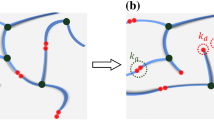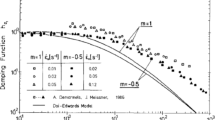Summary
The stress-strain-history relations derived byGreen andTobolsky for a relaxingGaussian molecular network with temporary junctions, generalized to allow for a distribution of junction mean lifetimes, have previously been used to calculate the elastic recovery which occurs in a polymer solution in a state of steady shear flow when all the stress components are instantaneously made zero. The equations predict that the instantaneous part of the recovery involves, in addition to the expected shear recovery, an expansion in directions normal to the previous lines of flow.
The present paper contains the corresponding calculations for the case in which this expansion is not allowed to take place, the liquid being constrained so that planesx 2=const. move rigidly in directions parallel to thex 1-axis during recovery as well as during the steady shear flow;x 1,x 2,x 3 denote coordinates relative to a rectangularCartesian coordinate system fixed in space. It is shown that the relation between shear stress and the time integral of shear strain is of the linear type much studied in the literature; the calculation of the behaviour ofp 11–p 22, the difference of two normal stress components, is new. It is shown that ifp 21, the shear stress component, be instantaneously made zero (following steady shear flow),p 11–p 22 also decreases instantaneously but in general takes time to reach the value zero; this is true even for the case in which all junctions have the same mean lifetime when the instantaneous shear recovery is not followed by any delayed recovery. The magnitudes of both instantaneous and ultimate shear recovery are calculated; it is found that the latter differs by a factor of two from that calculated on the hypothesis that the stress tensor in steady shear flow is an isotropic function of the strain tensor describing the ultimate shear recovery. The transient behaviour associated with the start of steady shear flow is also considered. Inertial forces are neglected throughout.
Zusammenfassung
Die Beziehungen zwischen der Spannung und dem Zeitintegral der Verformung, die vonGreen undTobolsky für ein sich entspannendes Gaußsches Netzwerk mit zeitweiligen Vernetzungen abgeleitet wurden, werden mit Berücksichtigung der Verteilung der mittleren Lebensdauer der Vernetzungen verallgemeinert. Diese Beziehungen sind schon früher benutzt worden, um die elastische Erholung zu berechnen, die erfolgt, wenn in einer Polymerlösung, die sich in einem Zustand stationärer Scherströmung befindet, alle Kräfte momentan gleich Null gesetzt werden. Die Gleichungen sagen aus, daß der Momentanteil der Erholung nicht nur eine voraussichtliche Schererholung, sondern auch eine Ausbreitung in den Richtungen normal zu den Strömungslinien einschließt.
Die vorliegende Abhandlung enthält die diesbezügliche Rechnung für den Fall, wo diese Ausbreitung nicht stattfinden kann, da die Flüssigkeit so umschlossen ist, daß die Ebenen normal zurx 2-Achse sich unnachgiebigerweise in den Richtungen parallel mit derx 1-Achse während der Erholung als auch während der stationären Scherströmung bewegen.x 1,x 2, undx 2 bezeichnen die Koordinaten bezüglich eines räumlich festen rechtwinkeligen, cartesischen Achsenkreuzes. Man erhält eine lineare Beziehung zwischen der Schubspannung und dem Zeitintegral der Schiebung, die im Schrifttum schon viel behandelt worden ist. Die Berechnung des Verhaltens der Differenz der zwei Normalspannungskomponentenp 11 undp 22 ist neu. Es wird gezeigt, daß wenn, bei stationärer Scherströmung, die Schubspannungskomponentep 21 momentan Null gesetzt wird, dannp 11 bisp 22 auch momentan abnimmt, aber im allgemeinen ist eine gewisse Zeit erforderlich, den Nullwert zu erreichen. Das trifft sogar dann zu, wenn alle Vernetzungen dieselbe mittlere Lebensdauer haben und wo der momentanen Schuberholung nicht eine verzögerte Erholung folgt. Die Beträge der momentanen und endgültigen Schererholung wurden berechnet. Die so ermittelte endgültige Schererholung beträgt die Hälfte derer, die man, von der Annahme ausgehend, daß der Spannungstensor der stationären Scherströmung eine isotrope Funktion des Verzerrungstensors, der die endgültige Schererholung beschreibt, sei, berechnet. Das vorübergehende Verhalten am Anfang der stationären Scherströmung ist auch in Betracht gezogen. Dagegen sind Trägheitskräfte durchweg vernachlässigt.
Similar content being viewed by others
References
Green, M. S., andA. V. Tobolsky, J. Chem. Phys.14, 80 (1946).
Lodge, A. S., Trans. Faraday Soc.52, 120 (1956).
Lodge, A. S., Rheology of Elastomers (London to appear in 1958).
Carslaw, H. S., andJ. C. Jaeger, Operational Methods in Mathematical Physics p. 285 (London 1948).
Copson, E. T., Functions of a Complex Variable, p. 79 (Oxford 1935).
Weissenberg, K., Nature159, 310 (1947).
Mooney, M., J. Colloid Sci.6, 96 (1951).
Author information
Authors and Affiliations
Rights and permissions
About this article
Cite this article
Lodge, A.S. A network theory of constrained elastic recovery in concentrated polymer solutions. Rheol Acta 1, 158–163 (1958). https://doi.org/10.1007/BF01968859
Received:
Issue Date:
DOI: https://doi.org/10.1007/BF01968859




